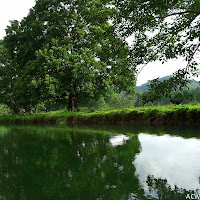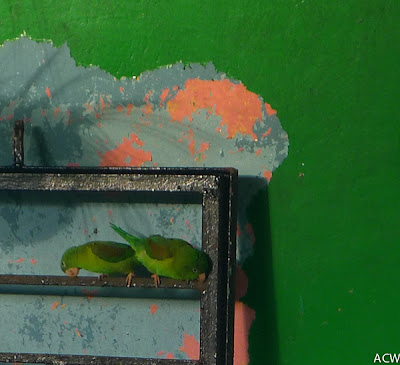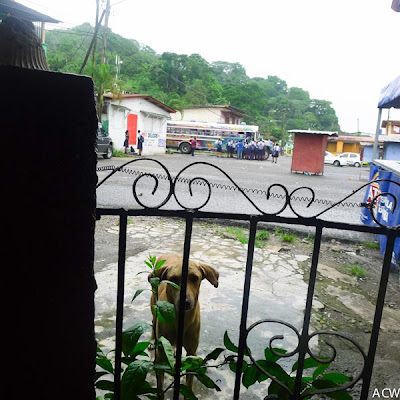image copied from http://www.cnngo.com/explorations/life/captain-morgan-549521
Portobelo, Panama, is the unofficial capital of the Costa Abajo, that stretch of Panama’s Caribbean Coast that runs west from Kuna Yala/San Blas. Behind the narrowish coastal plain there are big hills/small mountains (the tallest, Cerro Carti, is 748 meters).
The bay is nice and big, deep in the middle, shallow around the edges. Although open to the west, from whence can come some powerful rockin’and rollin’ when the tradewinds are in abeyance, it’s a pretty good harbor most of the time. The land is still quite wooded, but more and more now cleared in the service of cattle (McDonald’s, we hear you!) and small agriculture (spindly corn, bananas, tubers like yuca). A couple rivers come in at the east end, which make for nice dinghy excursions through the cattle bottoms.


To someone coming the 40 miles from the San Blas islands Portobelo feels like a big, even modern, place (5 Chinese grocery stores! buses to Colon! 3000 people! maybe). Also on our ‘haven’t seen that for a while’ list are wheeled vehicles larger than baby strollers, such as taxis, pickups, and dump trucks. There’s even a front-end loader in town, for moving the trash pile. Different body types, not just the small-framed Kuna people, but Anglos and Africans and lots of blended. The sound of howler monkeys is back with us (really makes me wonder why they’re never heard in the mainland areas of Kuna Yala) in an early morning duet with the screech of bus brakes (Bluebird ex-schoolbuses, splendidly painted and speaker-powered).
The buses have their own distinctions – and you’ll learn quickly which ones have the biggest speakers, and the hard-to-open windows, but you’ll get in anyway. Colon is an hour and a half away, and Panama City another hour or so, depending on traffic!
The Chinese groceries have distinct personalities too, and are full of surprises, but often short of fresh fruit and veg. For your nutritional needs, you listen for the loudspeakers screeching something from the top of a pickup-truck. If you’re quick you can usually find the truck somewhere in town, or wait around until he comes back a couple hours later from ‘the end of the road’ at Isla Grande/La Guiara.
The Portobelo of today is a funkily pleasant place that makes me think of all the complementary forces in the universe, feng shui and the ebb and flow of styles, fortunes, cultures partly in ascendance, partly in decline, like all of us. There are good things here, and friendly people, and some puzzles too.
What put Portobelo on the list of World Heritage sites is its history. The Spanish conquistadors began to use Portobelo as their major Caribbean loading place for the riches they were removing from South America. Gold and silver and others items valued by the Spanish were transported overland through the jungle to the Caribbean and loaded into convoys for shipment to Spain. Nuestra Senora de Atocha, the wrecked treasure ship that is the foundation of Mel Fisher’s Treasure Museum in Key West, sailed from here.
 |
| Nuestra Senora de Atocha, courtesy of theamericano.com |
“PORTOBELO ON THE SPANISH MAIN “The city was also victim of one of Captain Henry Morgan’s notorious adventures. In 1668, Morgan led a fleet of privateers and 450 men against Portobelo, which, in spite of its good fortifications, he captured and plundered for 14 days, stripping it of nearly all its wealth. This daring endeavour, although successful, also proved particularly brutal as it involved rape, torture, and murder on a grand scale.” from Wikipedia, and more in The Sack of Panama by Peter Earle.
We were anchored in the harbor on the 344th anniversary of this attack, during inclement weather, and it was interesting to go ashore with ‘new eyes’ after reading this.
Then, also according to Wikipedia, after another humiliation by the British under Admiral Edward Vernon, (in the War of Jenkins’ Ear), the Spanish redesigned the defenses. Vernon took a big loss in Cartagena, but the world was changing. The Spanish finally learned to make their fleets smaller; then ships more regularly sailed to western South America via Cape Horn. So the forts whose ruins decorate Portobelo today never were used as forts; they became quarries supplying stone for early Panama Canal construction. Also, mustn’t forget to mention that Sir Francis Drake died of dysentery and was buried at sea in a lead-coffin not too far away. Maybe someone will be finding that someday soon.
Today the Customs House, once reputedly so full that silver ingots were stored outside on the street, has a museum on the ground floor, and an evolutionary ‘garden’ on the roof. Plus, those are supposed to be the scars of British attack on the wall.
PHOTO TREASURE HOUSE ROOF
The forts have restored areas, reader boards and visitors who dutifully wander through.
PHOTO FORT WITH COWS
The hills are steep and all I can think as I myself trudge about, redoubt to lookout, is how dreadful it must have been to be the slave, conscript or flunky on any of these projects. Charged with clearing jungle, digging, shaping and moving stones, humping stuff up the slope, no matter the heat, humidity, insects, disease, nutritional deficiency – and for what? Such big ‘public works’ for so little ‘public.’ In hindsight it looks pointless and even at the time, it must have been difficult to muster enthusiasm, unless it was whipped in.
So Portobelo’s other big attraction is its church, Iglesia de San Felipe, whose interior features the Black Christ of Portobelo. The history of the life-sized image of Jesus carrying the Cross is shrouded in the mists of time, and imagination – carved in Spain? Washed ashore in Portobelo? But there are so many stories of miracles associated with the Black Christ that tens of thousands of pilgrims visit the Church (the new building, eventually completed in 1945) every October 21, some crawling on hands and knees. Reportedly, their number includes penitent rapists, muggers and thieves, the Black Christ being the patron saint of criminals, this according to http://www.coloncity.com/blackchrist.html.
PHOTO FAMILY AT BLACK CHRIST ALTAR

Nowadays Portobelo is where many backpackers come to find a ride to Cartagena by sea – as traffic can’t get through the Darien peninsula by road. It’s where a wide variety of craft come to make a bit of money on that trade, some excellent and some downright dangerous. It’s the first ‘big’ place people come to after cruising the San Blas, heading for the Canal, or for time away in Shelter Bay or Bocas del Toro. I’ll bet Captain Jack’s Canopy Bar, restaurant, hostel and gathering place up the hill sells a lot of hamburgers to long-deprived carnivorous cruisers.

Maybe something in the air from all those centuries of soldiers of fortune has provided leavening for new generations of their descendants. Portobelo has more than the usual number of gnarly single-handers and boats which may never leave here – a regular little community of them in fact. One fellow got his boat to rest high and dry on a reef, on purpose. He’s always pointed out of the harbor, but never going. Here’s my favorite: Absolute Absolution, a 53′ catamaran built via creative recycling of scavenged materials by someone not a naval architect. A mast on each hull. We’re all individuals out here, and there too. I need to find a better picture when I have access to my ‘stacks’, but you’ll perhaps get the idea.

“This is a “Fourth Way” project which will change its direction and details many times along the way.”
http://www.floatingneutrinos.com/Buoyant%20Neutrinos/background.htm#Photo%20Gallery. This website is pretty dense.
Unfortunately, the most famous Floating Neutrino died not too long ago – here’s his obituary from -yes -the Wall Street Journal – worth the read, IMO.
http://online.wsj.com/article/SB10001424052748704013604576104412565095674.html

Another thing that can be said about Portobelo is that it rains a lot here. Rust, mildew, damp, facts of life. Some of the ruined houses were knocked over in landslides last year. There are also an inordinate number of Black Vultures in town. They congregate on the roof of the cathedral, on the cemetery walls, on the trash pile (of course). Not the most charismatic of birds, but there are others!

Now, I think I’ve said enough about Portobelo. If you want to know more, you’ll just have to visit for yourself.
More photos here:
http://galivant.smugmug.com/Panama/Portobelo/24556216_D448fp#!i=2005529624&k=GpfnrKz
Books about history:
David Cordingly, Under the Black Flag


We’re watching you!

 Each Sunday there is a fifty-block ‘take back the calle’ street fair on Avenida Arequipa, where in addition to the bikes, skateboards, rollerblades, baby strollers and dogs, there was high-energy dancing, tai-chi -like something, free sports drinks, climbing walls, acrobatics, even an outdoor beauty parlor, all of which we surveyed from our rented bikes.
Each Sunday there is a fifty-block ‘take back the calle’ street fair on Avenida Arequipa, where in addition to the bikes, skateboards, rollerblades, baby strollers and dogs, there was high-energy dancing, tai-chi -like something, free sports drinks, climbing walls, acrobatics, even an outdoor beauty parlor, all of which we surveyed from our rented bikes.


















